French comedian Max Linder (1883-1925), with his trademark silk hat, stick and moustache, was an influential pioneer of the silent film. He was largely responsible for the creation of the classic slapstick comedy.
![Max Linder]()
French postcard by Helio Paul et Vigier, Paris. Publicity card for the Pathé-Baby projector.
![Max Linder]()
German postcard by Verlag Herm. Leiser, no. 9977. Photo: Gerlach.
![Max Linder]()
French postcard by Pathé Frères. Photo: Felix.
Max Linder was born Gabriel-Maximilien Leuvielle in Saint-Loubès, France in 1883 to a Jewish wine growing family.
He grew up with a passion for the stage and at 17 he dropped out of school in order to join a touring theatre troupe, which did not please his parents.
While working in Paris as an actor in the theatre and vaudeville, Leuvielle became fascinated with motion pictures. In 1905 he took a job with Pathé Frères and in the following years he became a comedic actor, director, screenwriter, as well as a producer under the stage name, Max Linder.
His debut was La première sortie d'un collégien/First Night Out (Louis J. Gasnier, 1905). He created what was probably the first identifiable film character: ‘Max’, an elegant, joyful, romantic, top-hatted dandy.
Max appeared for the first time in Les Debuts d'un patineur/Max Learns to Skate (Louis J. Gasnier, 1907) and would return in successive situation comedies. ‘Gentleman Max’ was frequently in hot water because of his penchant for beautiful women and the good life.
When in the credits for Max et la doctoresse/Max and the female doctor (Max Linder, 1909) the text “written by Max Linder and played by the author” appeared, it was the first time in film history that an author was mentioned in connection with a cinematic work.
![Max Linder]()
French postcard by Cinémagazine, no. 24.
![Max Linder]()
French postcard by Cinémagazine, no. 188.
![Max Linder]()
French postcard by Edition Pathé Frères.
After comedian André Deedwent to Italy, Max Linder moved up and became the comedy star no. 1 for Pathé.
In 1910 he shot one comedy each week. By 1911, Linder was directing all his own films as well as writing the script and the universality of silent films brought Linder fame and fortune throughout Europe. By 1912, he was the highest-paid film star in the world, with an unprecedented salary of one million francs.
His success didn't have any limits: whether Spain, Germany, Italy or Russia, Max Linder was everywhere welcomed with enthusiasm during his live entrances in the capital cities. In Russia the police had to call the Army for help so that Linder was able to leave the Moscow railroad station.
One of the best and more successful examples of his type of humour is the one-reeler Max et la Statue/Max and the Statue (Max Linder, 1912). Max attends a costume ball, dressed as a suit of armor. After drinking too much at the party, he passes out on the sidewalk. Meanwhile, during the evening, a new suit of armour to be unveiled at the Louvre the next day is stolen by a pair of thieves. The police, discovering the theft, stumble upon Max. They take him back to the Louvre where he is unveiled for the Museum committee. They depart, whereupon the thieves return, take Max, and, back in the hideout, attempt to open the armour with tools. Max awakens, scares the burglars, then, in the final frame, strolls away, strumming a guitar.
The weekly adventures of Max were impatiently awaited by faithful and enthusiastic audiences. In 1914 Linder decided to realise one of his old dreams: to start a cinema. He bought a cinema in Paris with 1,200 sears, created in 1912, the Kosmorama. The Ciné Max Linder opened in December 1914.
World War I brought a temporary end to Linder's career in film. Physically unfit for combat duty, he worked as a dispatch driver during the war until he was seriously wounded. He was gassed, and the illness that resulted would blight his career.
![Max Linder]()
French postcard. Photo Pathé.
![Max Linder]()
French postcard by Pathé Frères. Photo: Felix.
![Max Linder]()
French postcard by Pathé Frères. Photo: Felix.
While in the hospital in 1916, Max Linder was visited by George K. Spoor, president of Essanay films. Having lost Charlie Chaplin, Spoor wanted Linder to "take his place" and offered him $5,000 per week to write, direct, and star in 12 three-reel comedies to be made in the studio's Chicago location.
Linder went to the US, but his first few American-made Max films didn't make the same impression as the Chaplin shorts. Recurring ill-health meant that his US films had little of the sparkle of his early French work. After only three films were completed Linder headed back to France.
For the convalescence of his pleurisy, Linder went to the lake of Geneva. In 1919 it seemed like Max was his old self again and his screen version of Le Petit Café/The Little Cafe (Raymond Bernard, 1919) was received enthusiastically by critics and audiences on both sides of the Atlantic.
He made another attempt at film making in the US for the recently-formed United Artists(one of whose founders was Charles Chaplin). He worked as a film producer, screenwriter, director and leading actor in three films: Seven Years Bad Luck (Max Linder, 1921), Be My Wife (Max Linder, 1921), and the film he considered his best, the inventive parody The Three Must-Get-Theres (Max Linder, 1922).
Endowed with an overflowing imagination, he filled his films with an inexhaustible variety of gags. For example, Max was the original creator of the genius mirror gag in Seven Years Bad Luck, which the Marx Brothers used again so memorably in their film Duck Soup (Leo McCarey, 1933). These later films are now regarded as classics.
However, the work exhausted Max, and after finishing the last film he left the United States once again. Back in France he appeared in only two more films. In Au Secours!/Help! (Abel Gance, 1923) he played a tragic part. Later he forbade the showing because he feared his reputation as a comedian was in danger.
His last film, Der Zirkuskönig/King of the Circus (Max Linder, Édouard-Émile Violet, 1924) with Vilma Bánky, was made in Vienna, Austria. For the film Chevalier Barkas/The Knight Barkas he contacted the in those days unknown director René Clair. But the film would never be realised.
![Max Linder]()
French postcard by Pathé Frères. Photo: Felix.
![Max Linder]()
French postcard by A.N, Paris in the Les Vedettes de Cinéma series, no. 87. Photo: United Artists.
![Max Linder]()
Italian postcard by Casa Editrice Ballerini & Fratini, Firenze, no. 787.
The after-effects of Max Linder's war service was that he suffered from continuing health problems including bouts of severe depression.
In 1923, he married the 18 year old Hélène Peters, a wealthy Paris heiress, with whom he had a daughter, Maud. At the same year he sold his Max Linder cinema.
The emotional problems besetting Linder evidenced themselves when he and his wife made a suicide pact. In early 1924 they attempted suicide at a hotel in Vienna, Austria. They were found and were recuperated, but on 31 October 1925 Linder and his wife were successful in taking their lives in Paris.
After Linder's death, Chaplin dedicated one of his films: "For the unique Max, the great master - his student Charles Chaplin". But in the ensuing years, Max Linder was relegated to little more than a footnote in film history.
In 1963, a compilation film titled En compagnie de Max Linder/Laugh with Max Linder was released. Later his daughter made a documentary film titled L'homme au chapeau de soie/The Man in the Silk Hat (Maud Linder, 1983). Max Linder's comic gestures, planned expressions, anachronisms, contrasts, and use of the unexpected, as well as his comic chase scenes (pursuits) became again the inspiration for young comedians.
Max Linder appeared in more than 400 films, mostly short comedies. Only about 80 survive. His daughter and the keeper of his heritage, Maud Linder, passed away on 25 October 2017).
Clip with Max Linder and Maurice Tourneur in Champion de boxe/Boxing Champion (1910). Source: TheBzzz (YouTube).
![Max Linder, Paris]()
A May 2009 photo of the Max Linder cinema in Paris.
![Cinema Ritrovato, Bologna, Pathe posters]()
Left a poster for the Max Linder comedy Avant et après/Before and After, exhibited at the Cinema Ritrovato festival 2009. Atrium of the Lumiere cinema, Bologna, Italy.
Sources: Thomas Staedeli (Cyranos), Michael Brooke (IMDb), Wikipedia, Golden Silents, and IMDb.
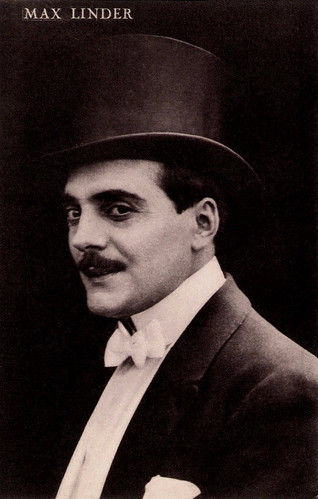
French postcard by Helio Paul et Vigier, Paris. Publicity card for the Pathé-Baby projector.
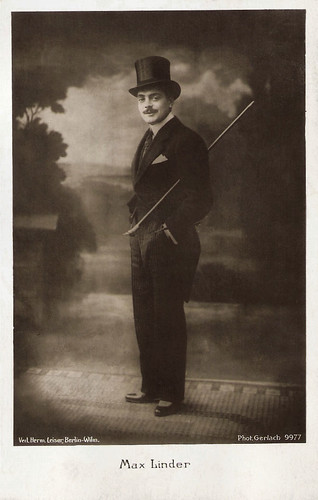
German postcard by Verlag Herm. Leiser, no. 9977. Photo: Gerlach.
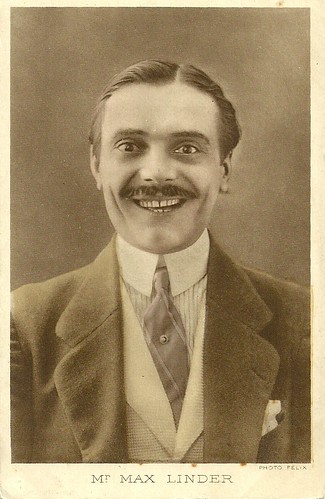
French postcard by Pathé Frères. Photo: Felix.
Gentleman Max
Max Linder was born Gabriel-Maximilien Leuvielle in Saint-Loubès, France in 1883 to a Jewish wine growing family.
He grew up with a passion for the stage and at 17 he dropped out of school in order to join a touring theatre troupe, which did not please his parents.
While working in Paris as an actor in the theatre and vaudeville, Leuvielle became fascinated with motion pictures. In 1905 he took a job with Pathé Frères and in the following years he became a comedic actor, director, screenwriter, as well as a producer under the stage name, Max Linder.
His debut was La première sortie d'un collégien/First Night Out (Louis J. Gasnier, 1905). He created what was probably the first identifiable film character: ‘Max’, an elegant, joyful, romantic, top-hatted dandy.
Max appeared for the first time in Les Debuts d'un patineur/Max Learns to Skate (Louis J. Gasnier, 1907) and would return in successive situation comedies. ‘Gentleman Max’ was frequently in hot water because of his penchant for beautiful women and the good life.
When in the credits for Max et la doctoresse/Max and the female doctor (Max Linder, 1909) the text “written by Max Linder and played by the author” appeared, it was the first time in film history that an author was mentioned in connection with a cinematic work.
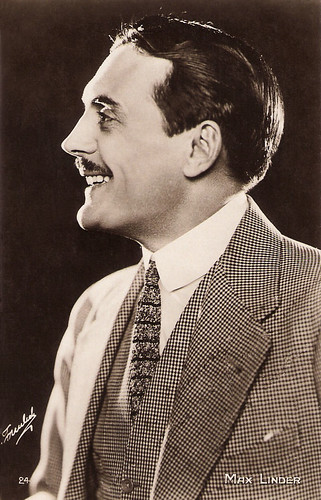
French postcard by Cinémagazine, no. 24.

French postcard by Cinémagazine, no. 188.
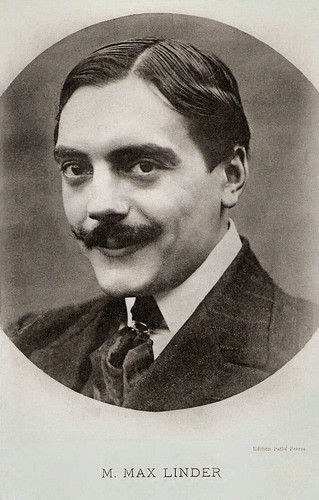
French postcard by Edition Pathé Frères.
Comedy Star No. 1
After comedian André Deedwent to Italy, Max Linder moved up and became the comedy star no. 1 for Pathé.
In 1910 he shot one comedy each week. By 1911, Linder was directing all his own films as well as writing the script and the universality of silent films brought Linder fame and fortune throughout Europe. By 1912, he was the highest-paid film star in the world, with an unprecedented salary of one million francs.
His success didn't have any limits: whether Spain, Germany, Italy or Russia, Max Linder was everywhere welcomed with enthusiasm during his live entrances in the capital cities. In Russia the police had to call the Army for help so that Linder was able to leave the Moscow railroad station.
One of the best and more successful examples of his type of humour is the one-reeler Max et la Statue/Max and the Statue (Max Linder, 1912). Max attends a costume ball, dressed as a suit of armor. After drinking too much at the party, he passes out on the sidewalk. Meanwhile, during the evening, a new suit of armour to be unveiled at the Louvre the next day is stolen by a pair of thieves. The police, discovering the theft, stumble upon Max. They take him back to the Louvre where he is unveiled for the Museum committee. They depart, whereupon the thieves return, take Max, and, back in the hideout, attempt to open the armour with tools. Max awakens, scares the burglars, then, in the final frame, strolls away, strumming a guitar.
The weekly adventures of Max were impatiently awaited by faithful and enthusiastic audiences. In 1914 Linder decided to realise one of his old dreams: to start a cinema. He bought a cinema in Paris with 1,200 sears, created in 1912, the Kosmorama. The Ciné Max Linder opened in December 1914.
World War I brought a temporary end to Linder's career in film. Physically unfit for combat duty, he worked as a dispatch driver during the war until he was seriously wounded. He was gassed, and the illness that resulted would blight his career.
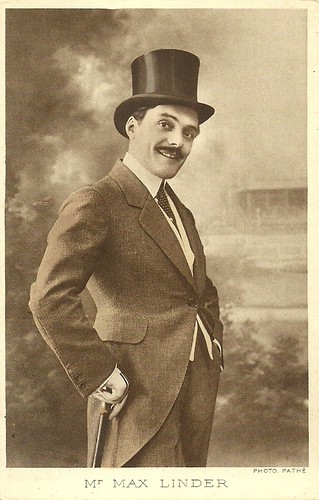
French postcard. Photo Pathé.
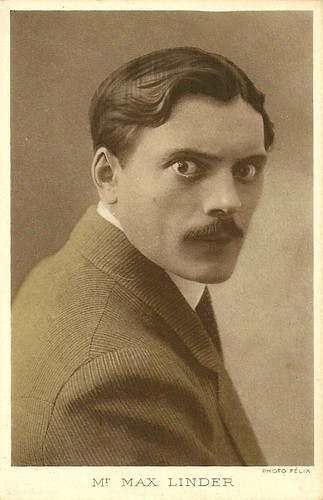
French postcard by Pathé Frères. Photo: Felix.
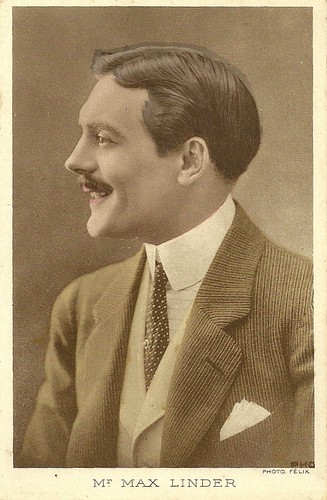
French postcard by Pathé Frères. Photo: Felix.
America
While in the hospital in 1916, Max Linder was visited by George K. Spoor, president of Essanay films. Having lost Charlie Chaplin, Spoor wanted Linder to "take his place" and offered him $5,000 per week to write, direct, and star in 12 three-reel comedies to be made in the studio's Chicago location.
Linder went to the US, but his first few American-made Max films didn't make the same impression as the Chaplin shorts. Recurring ill-health meant that his US films had little of the sparkle of his early French work. After only three films were completed Linder headed back to France.
For the convalescence of his pleurisy, Linder went to the lake of Geneva. In 1919 it seemed like Max was his old self again and his screen version of Le Petit Café/The Little Cafe (Raymond Bernard, 1919) was received enthusiastically by critics and audiences on both sides of the Atlantic.
He made another attempt at film making in the US for the recently-formed United Artists(one of whose founders was Charles Chaplin). He worked as a film producer, screenwriter, director and leading actor in three films: Seven Years Bad Luck (Max Linder, 1921), Be My Wife (Max Linder, 1921), and the film he considered his best, the inventive parody The Three Must-Get-Theres (Max Linder, 1922).
Endowed with an overflowing imagination, he filled his films with an inexhaustible variety of gags. For example, Max was the original creator of the genius mirror gag in Seven Years Bad Luck, which the Marx Brothers used again so memorably in their film Duck Soup (Leo McCarey, 1933). These later films are now regarded as classics.
However, the work exhausted Max, and after finishing the last film he left the United States once again. Back in France he appeared in only two more films. In Au Secours!/Help! (Abel Gance, 1923) he played a tragic part. Later he forbade the showing because he feared his reputation as a comedian was in danger.
His last film, Der Zirkuskönig/King of the Circus (Max Linder, Édouard-Émile Violet, 1924) with Vilma Bánky, was made in Vienna, Austria. For the film Chevalier Barkas/The Knight Barkas he contacted the in those days unknown director René Clair. But the film would never be realised.
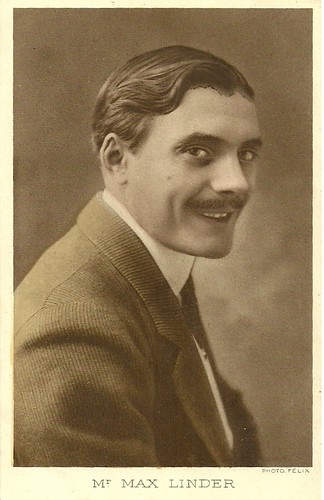
French postcard by Pathé Frères. Photo: Felix.
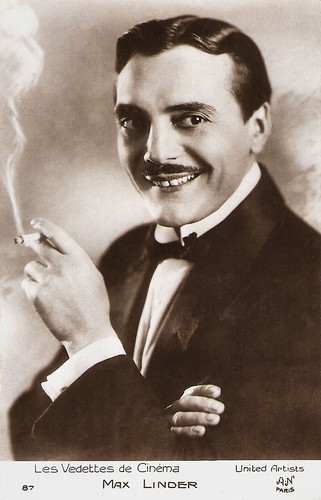
French postcard by A.N, Paris in the Les Vedettes de Cinéma series, no. 87. Photo: United Artists.

Italian postcard by Casa Editrice Ballerini & Fratini, Firenze, no. 787.
Suicide Pact
The after-effects of Max Linder's war service was that he suffered from continuing health problems including bouts of severe depression.
In 1923, he married the 18 year old Hélène Peters, a wealthy Paris heiress, with whom he had a daughter, Maud. At the same year he sold his Max Linder cinema.
The emotional problems besetting Linder evidenced themselves when he and his wife made a suicide pact. In early 1924 they attempted suicide at a hotel in Vienna, Austria. They were found and were recuperated, but on 31 October 1925 Linder and his wife were successful in taking their lives in Paris.
After Linder's death, Chaplin dedicated one of his films: "For the unique Max, the great master - his student Charles Chaplin". But in the ensuing years, Max Linder was relegated to little more than a footnote in film history.
In 1963, a compilation film titled En compagnie de Max Linder/Laugh with Max Linder was released. Later his daughter made a documentary film titled L'homme au chapeau de soie/The Man in the Silk Hat (Maud Linder, 1983). Max Linder's comic gestures, planned expressions, anachronisms, contrasts, and use of the unexpected, as well as his comic chase scenes (pursuits) became again the inspiration for young comedians.
Max Linder appeared in more than 400 films, mostly short comedies. Only about 80 survive. His daughter and the keeper of his heritage, Maud Linder, passed away on 25 October 2017).
Clip with Max Linder and Maurice Tourneur in Champion de boxe/Boxing Champion (1910). Source: TheBzzz (YouTube).
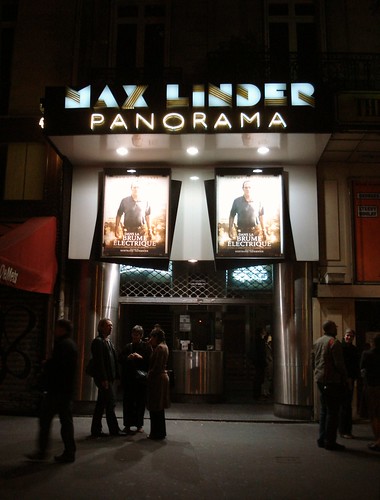
A May 2009 photo of the Max Linder cinema in Paris.
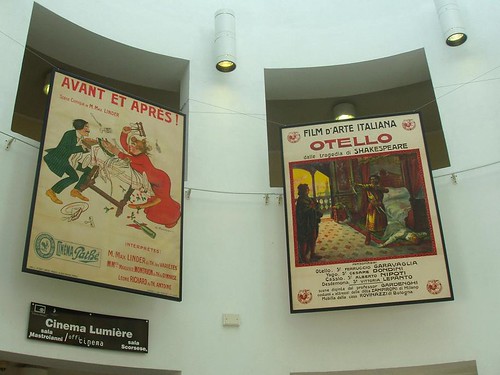
Left a poster for the Max Linder comedy Avant et après/Before and After, exhibited at the Cinema Ritrovato festival 2009. Atrium of the Lumiere cinema, Bologna, Italy.
Sources: Thomas Staedeli (Cyranos), Michael Brooke (IMDb), Wikipedia, Golden Silents, and IMDb.